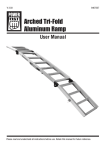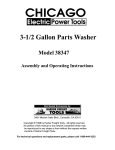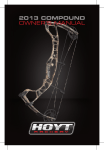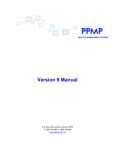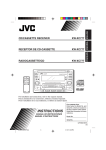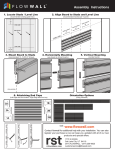Download Harbor Freight Tools 34313 User's Manual
Transcript
EXCESS CARGO CARRIER ASSEMBLY and OPERATING INSTRUCTIONS ® 3491 Mission Oaks Blvd. / Camarillo, CA 93011 Copyright © 1997 by Harbor Freight Tools®. All rights reserved. No portion of this manual or any artwork contained herein may be reproduced in any shape or form without the express written consent of Harbor Freight Tools. For technical questions and replacement parts, please call 1-800-444-3353. ® SPECIFICATIONS Platform Dimensions Carrying Capacity Hitch Size Total Weight 20" x 60" 500 lbs. 2" Standard 52 lbs. SAVE THIS MANUAL You will need the manual for the safety warnings and cautions, assembly instructions, operating procedures, maintenance procedures, trouble shooting, parts list, and diagram. Keep your invoice with this manual. Write the invoice number on the inside of the front cover. Keep both this manual and your invoice in a safe, dry place for future reference. SAFETY WARNING & CAUTIONS WARNING: When using electric tools, machines, or equipment, basic safety precautions should always be followed to reduce the risk of fire, electric shock, and personal injury. READ ALL INSTRUCTIONS BEFORE USING THIS TOOL! 1. KEEP WORK AREA CLEAN. Cluttered areas invite injuries. 2. OBSERVE WORK AREA CONDITIONS. Do not use machines or power tools in damp, wet, or poorly lit locations. Don’t expose to rain. Keep work area well lit. Do not use electrically powered tools in the presence of flammable gases or liquids. 3. KEEP CHILDREN AWAY. Children must never be allowed in the work area. Do not let them handle machines, tools, or extension cords. 4. STORE IDLE EQUIPMENT. When not in use, tools must be locked up in a dry location to inhibit rust. Always lock up tools and keep out of reach of children. 5. DO NOT FORCE THE TOOL. It will do the job better and more safely at the rate for which it was intended. Do not use inappropriate attachments in an attempt to exceed the tool’s capacities. 6. USE THE RIGHT TOOL FOR THE JOB. Do not attempt to force a small tool or attachment to do the work of a larger industrial tool. Do not use a tool for a purpose for which it was not intended. 7. DRESS PROPERLY. Do not wear loose clothing or jewelry as they can be caught in moving parts. Protective, electrically non-conductive clothes and non-skid footwear are recommended when working. Wear restrictive hair covering to contain long hair. 8. USE EYE AND EAR PROTECTION. Always wear ANSI approved chemical splash goggles when working with chemicals. Always wear ANSI approved impact safety goggles at other Page 2 -- SKU: 34313 ® times. Wear a full face shield if you are producing metal filings or wood chips. Wear an ANSI approved dust mask or respirator when working around metal, wood, and chemical dusts and mists. 9. DO NOT ABUSE THE POWER CORD. Do not yank it to disconnect it from the receptacle. Do not carry tools by the cord. 10. DO NOT OVERREACH. Keep proper footing and balance at all times. Do not reach over or across running machines. 11. MAINTAIN TOOLS WITH CARE. Keep tools sharp and clean for better and safer performance. Follow instructions for lubricating and changing accessories. Inspect tool cords periodically and, if damaged, have them repaired by an authorized technician. The handles must be kept clean, dry, and free from oil and grease at all times. 12. DISCONNECT POWER. Unplug when not in use, before servicing, and when changing accessories. 13. REMOVE ADJUSTING KEYS AND WRENCHES. Make it a habit to check that keys and adjusting wrenches are removed from the tool or machine work surface before plugging it in. 14. AVOID UNINTENTIONAL STARTING. Be sure the switch is in the OFF position when not in use and before plugging in. Do not carry any tool with your finger on the trigger, whether it is plugged in or not. 15. OUTDOOR EXTENSIONS CORDS. When the equipment is operated outdoors, use only extension cords intended for outside use. See chart under “Extension Cords” for the proper AWG rating depending on the length of the cord(s) being used. 16. STAY ALERT. Watch what you are doing; use common sense. Do not operate any tool when you are tired. 17. CHECK DAMAGED PARTS. Before using any tool, any part that appears damaged should be carefully checked to determine that it will operate properly and perform its intended function. Check for alignment and binding of moving parts; any broken parts or mounting fixtures; and any other condition that may affect proper operation. Any part that is damaged should be properly repaired or replaced by a qualified technician. Do not use the tool if any switch does not turn on and off properly. 18. GUARD AGAINST ELECTRIC SHOCK. Prevent body contact with grounded surfaces such as pipes, radiators, ranges, and refrigerator enclosures. 19. REPLACEMENT PARTS AND ACCESSORIES. When servicing, use only identical replacement parts. Use of any other parts will void the warranty. Only use accessories intended for use with this tool. Approved accessories are available from Harbor Freight Tools. 20. DO NOT OPERATE TOOL IF UNDER THE INFLUENCE OF ALCOHOL OR DRUGS. Read warning labels on prescriptions to determine if your judgment or reflexes are impaired while taking drugs. If there is any doubt, do not operate the tool. Page 3 -- SKU: 34313 REV 09/02 UNPACKING If any parts are missing or broken, please call Harbor Freight Tools at the number on the cover of this manual. Ref A N/A B C1 C2 D Item Description Receiver Mounting Bar Hardware Bag Detachable Side Rail Side Rail Brace Side Rail Brace Bed Frame Quantity 1 1 2 3 3 1 Caution: Be aware of the possible risk of fire and damage to property resulting from the vehicle’s exhaust pipe pointing at the cargo put in this Cargo Carrier. Before installing the Cargo Carrier, check to make sure that the exhaust pipe is not pointing in the direction of the cargo. Flammable cargo can ignite from exposure to heat. Other cargo can be damaged from the heat. Always be aware of this potential danger, and never use the Cargo Carrier if this risk exists. ASSEMBLY Step 1: Place all the pieces for your Excess Cargo Carrier onto a clear work area. Step 2: Make sure the set of three holes in the RECEIVER MOUNTING BAR (#A) are oriented vertically. Turn the RECEIVER MOUNTING BAR to properly orient it. Step 3: Insert the RECEIVER MOUNTING BAR (#A) under the mesh screen of the BED FRAME (#D) and between the arched Bed Frame Supports as shown in Figure 1. Bed Frame (#D) Receiver Mounting Bar (#A) Figure 1 — Attatching the Mounting Receiver Bar Page 4 -- SKU: 34313 REV 09/02 REV 10/02 ® Step 4: Insert two HEX BOLTS (#E) through the top of the BED FRAME and down through the RECEIVER MOUNTING BAR as shown in Figure 2. Hex Bolts (#E) Nuts (#F) Figure 2 — Inserting Hex Bolts Step 5: Attach a NUT (#F) to each of the HEX BOLTS and tighten. Detachable Side Rails The following Steps show how to assemble the DETACHABLE SIDE RAILS (#B). These side rails should always be in place when using the Excess Cargo Carrier. Page 5 -- SKU: 34313 REV 09/02 Step 1: Attach one DETACHABLE SIDE RAIL to the outside corners of the BED FRAME as shown in Figure 3. Assemble with one BOLT (#G) and one NUT (#H) per corner. Tighten the NUTS. Bolt (#G) Detachable Side Rail (#B) Nut (#H) Detachable Side Rail (#B) Bolt (#G) Nut (#H) Figure 3 — Attaching Side Rails Step 2: Place a SIDE RAIL BRACE (#C1) outside on the vertical folded edges of the DETACHABLE SIDE RAIL and BED FRAME as shown in Figure 4. Nuts (#H) Side Rail Brace (#C1) Bolts (#G) Figure 4 — Attaching Center Side Rail Braces Page 6 -- SKU: 34313 ® Step 3: Assemble with two BOLTS (#G) and two NUTS (#H) using the holes in the DETACHABLE SIDE RAIL and BED FRAME. Tighten the NUTS. Step 4: Attach a SIDE RAIL BRACE (#C2) to the inside vertical folded edges of the corner of the Carrier Assembly as shown in Figure 5. Attach with two BOLTS and two NUTS. Tighten the NUTS. Side Rail Brace (#C2) Nuts (#H) Side Rail Brace (#C2) Bolts (#G) Bolts (#G) Figure 5 — Attaching Corner Side Rail Braces Step 5: Repeat Step 4 for the other corner of the Carrier Assembly. Step 6: Repeat Steps 1 through 5 to assemble the second DETACHABLE SIDE RAIL. Your Excess Cargo Carrier is ready for use. Page 7 -- SKU: 34313 REV 09/02 OPERATION Step 1: Request a friend’s help to lift the Excess Cargo Carrier. Step 2: Lift the Excess Cargo Carrier and place the RECEIVER MOUNTING BAR into the Hitch Receiver mounted to your vehicle. Step 3: Line up the horizontal hole in the RECEIVER MOUNTING BAR with the hole in your Hitch. When the holes line up, place your locking mechanism through the holes to secure the Excess Cargo Carrier. Your Excess Cargo Carrier can be loaded with up to 500 lbs. of cargo. Caution: The load weight must be centered or evenly distributed across the Bed Frame (D). Always use appropriate tie-down restraints to securely attach any cargo loaded onto the Excess Cargo Carrier before moving your vehicle any distance. Do not leave loose items on the BED FRAME while operating the vehicle. DO NOT EXCEED THE MANUFACTURER’S RECOMMENDED PRODUCT WEIGHT CAPACITY. Doing so can result in personal injury and/or damage to the product. Caution: Be aware of dynamic loading! If the vehicle hits a bump, a slight play in the receiving hitch or a movement in the load could result in a momentary dynamic loading effect that could dramatically increase the actual load weight. This momentary dynamic loading effect could result in damage to the Excess Cargo Carrier, damage to the load and possible personal injury. Note: Any load over 350 Lbs. requires a Class 3 hitch on the vehicle. (Class 2 Hitch = 350 Lbs. maximum tongue weight) (Class 3 Hitch = 500 Lbs. maximum tongue weight) PARTS LIST Item# Description Qty Item# Description Qty A B C1 C2 D Receiver Mounting Bar Detachable Side Rail Side Rail Brace Side Rail Brace Bed Frame 1 2 2 4 1 E F G H Hex Bolt M10 Nut M10 Hex Bolt M6 Nut M6 2 2 16 16 Page 8 -- SKU: 34313 REV 09/02 ® ASSEMBLY DIAGRAM DISCLAIMER PLEASE READ THE FOLLOWING CAREFULLY THE MANUFACTURER AND/OR DISTRIBUTOR HAS PROVIDED THE PARTS DIAGRAM IN THIS MANUAL AS A REFERENCE TOOL ONLY. NEITHER THE MANUFACTURER NOR DISTRIBUTOR MAKES ANY REPRESENTATION OR WARRANTY OF ANY KIND TO THE BUYER THAT HE OR SHE IS QUALIFIED TO MAKE ANY REPAIRS TO THE PRODUCT OR THAT HE OR SHE IS QUALIFIED TO REPLACE ANY PARTS OF THE PRODUCT. IN FACT, THE MANUFACTURER AND/OR DISTRIBUTOR EXPRESSLY STATES THE ALL REPAIRS AND PARTS REPLACEMENTS SHOULD BE UNDERTAKEN BY CERTIFIED AND LICENSED TECHNICIANS AND NOT BY THE BUYER. THE BUYER ASSUMES ALL RISK AND LIABILITY ARISING OUT OF HIS OR HER REPAIRS TO THE ORIGINAL PRODUCT OR REPLACEMENT PARTS THERETO, OR ARISING OUT OF HIS OR HER INSTALLATION OF REPLACMENT PARTS THERETO. Page 9 -- SKU: 34313









